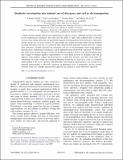Files in this item
Qualitative investigation into students’ use of divergence and curl in electromagnetism
Item metadata
| dc.contributor.author | Bollen, Laurens | |
| dc.contributor.author | van Kampen, Paul | |
| dc.contributor.author | Baily, Charles | |
| dc.contributor.author | De Cock, Mieke | |
| dc.date.accessioned | 2016-11-22T16:30:11Z | |
| dc.date.available | 2016-11-22T16:30:11Z | |
| dc.date.issued | 2016-10-19 | |
| dc.identifier | 247863987 | |
| dc.identifier | 5a288646-707c-4f84-a921-70fba3554011 | |
| dc.identifier | 85011395630 | |
| dc.identifier | 000393401300001 | |
| dc.identifier.citation | Bollen , L , van Kampen , P , Baily , C & De Cock , M 2016 , ' Qualitative investigation into students’ use of divergence and curl in electromagnetism ' , Physical Review Physics Education Research , vol. 12 , no. 2 , 020134 . https://doi.org/10.1103/PhysRevPhysEducRes.12.020134 | en |
| dc.identifier.issn | 2469-9896 | |
| dc.identifier.other | ORCID: /0000-0001-6213-503X/work/41932058 | |
| dc.identifier.uri | https://hdl.handle.net/10023/9866 | |
| dc.description.abstract | Many students struggle with the use of mathematics in physics courses. Although typically well trained in rote mathematical calculation, they often lack the ability to apply their acquired skills to physical contexts. Such student difficulties are particularly apparent in undergraduate electrodynamics, which relies heavily on the use of vector calculus. To gain insight into student reasoning when solving problems involving divergence and curl, we conducted eight semistructured individual student interviews. During these interviews, students discussed the divergence and curl of electromagnetic fields using graphical representations, mathematical calculations, and the differential form of Maxwell’s equations. We observed that while many students attempt to clarify the problem by making a sketch of the electromagnetic field, they struggle to interpret graphical representations of vector fields in terms of divergence and curl. In addition, some students confuse the characteristics of field line diagrams and field vector plots. By interpreting our results within the conceptual blending framework, we show how a lack of conceptual understanding of the vector operators and difficulties with graphical representations can account for an improper understanding of Maxwell’s equations in differential form. Consequently, specific learning materials based on a multiple representation approach are required to clarify Maxwell’s equations. | |
| dc.format.extent | 14 | |
| dc.format.extent | 1094245 | |
| dc.language.iso | eng | |
| dc.relation.ispartof | Physical Review Physics Education Research | en |
| dc.subject | QC Physics | en |
| dc.subject | NDAS | en |
| dc.subject.lcc | QC | en |
| dc.title | Qualitative investigation into students’ use of divergence and curl in electromagnetism | en |
| dc.type | Journal article | en |
| dc.contributor.institution | University of St Andrews. School of Physics and Astronomy | en |
| dc.identifier.doi | 10.1103/PhysRevPhysEducRes.12.020134 | |
| dc.description.status | Peer reviewed | en |
This item appears in the following Collection(s)
Items in the St Andrews Research Repository are protected by copyright, with all rights reserved, unless otherwise indicated.

